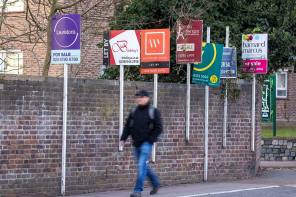

A two-speed market has emerged in the buy-to-let sector as smaller landlords have stopped adding to their portfolios, according to Kent Reliance.
The lender's latest Buy-to-let Britain report revealed that in the last three months, investors with more than 10 properties made one additional purchase but growth remained flat among those with less than five properties.
As investors with just a single property make up 62 per cent of landlords, a lack of growth in this segment of the market is holding back supply, Kent Reliance said.
The number of households in the sector grew at a rate of just 2.2 per cent in the third quarter - less than a third of the pace seen in 2014.
Demand from tenants has also dropped, and while average rents reached a new high of £895 a month across Great Britain, the rate of inflation has slowed from 2.4 per cent a year ago to 1.5 per cent.
Just 41 per cent of landlords said they were confident about the prospects for their portfolios – a slight increase on the previous quarter but far less than in recent years.
The emergence of a two-speed market followed the introduction of a 3 per cent stamp duty surcharge for additional property purchases in April 2016 and the announcement that income tax relief for landlords would be gradually phased out by 2020, starting in April 2017.
A further blow came with the Prudential Regulation Authority’s (PRA) introduction of more stringent affordability rules on 1 January this year, followed by stricter underwriting guidelines for portfolio landlords brought in at the end of September.
The cut to tax relief has driven a surge in borrowing via limited companies, which are not affected by the changes.
During the first three quarters of 2017, seven out of 10 buy-to-let applications for house purchase were via limited companies - up from 45 per cent in 2016 as a whole.
The value of the private rented sector has risen by 6.4 per cent in the past year to £1.4tn, driven by a 4.2 per cent uplift in the price of the average rental property.
Kent Reliance's findings are taken from a survey of 856 landlords, conducted in association with BDRC Continental in the third quarter of 2017, along with ONS population projections, English Housing Survey data and information from UK Finance.
Andy Golding, chief executive of OneSavings Bank, which trades under the Kent Reliance and InterBay brands in buy-to-let, said: "Landlords are swallowing the unpleasant cocktail of higher taxation and tighter regulation, and this is undermining the expansion of the private rented sector.
"A fundamental shift in the landlord population is now underway, as buy-to-let moves from being a popular past-time for hundreds of thousands of British amateur landlords, to the preserve of committed long-term investors with experience and expertise.
“The pace of professionalisation will only increase following the PRA’s latest moves, and incorporation continues apace.”
Mike Richards, director at London-based Mortgage Concepts Associates, said: “It does make sense. For those who already have 10 properties, it is their main job, and they are looking to do more, whereas those with just one or a couple are thinking they don’t want to do any more – it is going to be horrendous.
“Once you get to four or five properties, you have to do things to the properties, you have people leaving, and people do find it worrying.
“If you are in the business already, you would look at getting more – but not as much as you would have done in the past.
“I can’t see [buy-to-let] going backwards, but I can see it staying where it is or becoming subject to more aggressive measures from the government.”
simon.allin@ft.com



